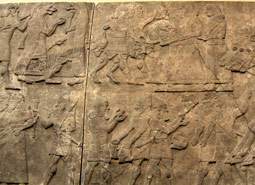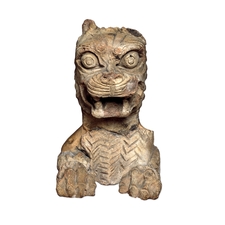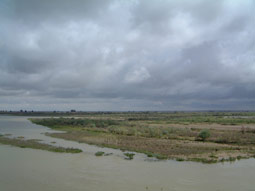Lamentation & ritual: performances of purity and penitence
Cleanliness is next to godliness, as the saying goes. But what constituted cultic purity TT in ancient Assyria and why did it matter so much to the king? The royal scholars' correspondence is full of references to ritual TT performances in which the king was closely consulted or even expected to take part. Some of those rituals, such as coronations and funerals, were public rites of passage. Some, such as the New Year Festival, were regular features of the royal and religious year. Others, most notably the Substitute King Ritual, were apologetic responses to divine warnings sent through the medium of omens, while still others were designed to ward off evil or the gods' displeasure.
Routine ritual: renewal of rule

Rituals could also be celebratory. Here lion-cloaked performers and soldiers dance with the decapitated heads of their defeated enemies. Detail from the stone decoration of Assurnasirpal's Northwest Palace at Nimrud, c.865-860 BC (room B, panel 8, top register; BM ANE 124548). Photo by Eleanor Robson. View large image.
The Assyrian new year began in the spring, on the first new moon after the equinox TT . It was marked by an eleven-day akitu festival which celebrated Aššur's PGP status as the primary deity of the realm and the king as his humble representative on earth. According to later, Babylonian accounts, the climax of the ceremony was an all-night recital of the Epic of Creation TT to Aššur (or Marduk PGP in Babylon PGP ), recounting his defeat of the forces of evil and chaos, out of which he created the human world. Once the temple had been washed with the blood of a sacrificed ram, the king entered and was humiliated before the god's statue until granted absolution by the deity. The successful renewal of his right to rule was celebrated with a grand procession of the king and all the gods to a special akitu temple outside Nineveh PGP , which Esarhaddon's father Sennacherib PGP had decorated with scenes of Aššur's triumph over the chaotic, primordial sea. Similar rituals were performed at the autumn equinox too.
According to the Epic, Aššur's first act of creation was to set the skies in motion. The stars (the "counterparts" of the gods) were to rise and set regularly over the year while the moon was to run on a 30-day cycle of appearance and disappearance in rhythm with the sun. Royal astrologers TT closely observed the skies for any deviance from this ideal calendar, and advised the king on when an extra month was needed to keep the solar and lunar years synchronised. Esarhaddon's chief exorcist TT Marduk-šakin-šumi PGP recommended an extra sixth month TT in 670 BC, just before the autumn akitu festival in Babylon (SAA 10: 253). There was a last-minute scramble to postpone the ceremonies, with knock-on effects for the regular rituals of the month before. The news reached Babylon just too late: the scholar Mar-Issar PGP wrote back to explain that he had called a halt only after the sixth day of ritual had been performed (SAA 10: 357).
Saying sorry

In another cosmic battle, the warrior god Ninurta defeats the lion-eagle Anzu, who has stolen the gods' Tablet of Destinies and is using it to try and turn back time. Detail from the stone decoration of the temple of Ninurta at Nimrud, c.865-860 BC (BM ANE 124571-2). Photo by Eleanor Robson. View large image.
At the heart of the akitu festival was the king's grovelling apology before Aššur for all the wrongs he had committed in the previous year. But the gods did not necessarily wait for this six-monthly opportunity to show their displeasure: they were in constant communication with the king through omimous signals of their approbation or disapproval. If his astrologers observed a disturbing celestial or terrestrial portent, or the haruspices TT received an unfavourable answer to an extispicy query, or a member of the royal family fell ill, then it was time to make amends with the divine world through a combination of apologetic lamentation and the re-purification of people and places.
Lamentation was the preserve of the kalû, or lamentation priest, an ancient profession whose origins can be traced back into the middle of the third millennium BC. The lamentation priests of the Assyrian royal court, headed by Urad-Ea PGP , focussed on responses to celestial omens: indeed Urad-Ea also wrote astrological reports for the king (SAA 8: 181, 182, 183). When the appearance (or non-appearance) of a heavenly body boded ill, he and his colleagues performed penitential laments (balaggu) and psalms (eršahungu) addressed to the appropriate deity, accompanied by the music of enormous kettledrums TT . For instance, a kettledrum ritual addressed to Nergal PGP (SAA 10: 340) seems to have been occasioned by the near conjunction of Mars PGP (Nergal's celestial "counterpart") and Saturn PGP within a lunar halo TT in late 670 BC. This inauspicious omen was reported to Esarhaddon by some ten different astrologers as well as Urad-Ea (SAA 8: 41, 48, 49, 82, 102, 125, 168, 169, 181, 327, 383, 416, 491; SAA 10: 47). In this configuration Mars/Nergal, god of plague and pestilence, boded ill for Assyria and thus needed to be placated. The king himself was absent from the ritual, but represented by the presence of his royal garments.
Laments and psalms, addressed to the stars and planets, were not in Akkadian but in Emesal, a ritual dialect of the ancient Sumerian language. Emesal may once have been spoken as a mother tongue but by the 7th century BC it had been the exclusive preserve of the lamenters for perhaps a thousand years. Many of the cultic chants had been passed down from ancient times too. The lamentation priests' letters do not record the names of the compositions they sang, but many survive on tablets from Assurbanipal's Library, as does a catalogue listing nearly sixty laments with their associated psalms. Thus it is likely that the lament Urad-Ea performed in front of Nergal was the one that begins:
Flood which drowns the harvest, what can one know about you?
Honoured one, flood which drowns the harvest, what can one know about you?
Bison, hero, Nergal! Great hero, Meslamtaea! Bison, great bull, mighty lord!
Great hero, lord who leads the cattle procession! Bison, lord Pisansagunuga!
And so on, praising and soothing the god for some 200 lines.
Surviving tablets also give instructions for the ritual construction of the lamenters' kettledrums from the hide of a sacrificed bull. The live bull (presumably under heavy sedation) was brought into a ritually clean space, made to stand on a reed mat, and surrounded by a magic circle of flour TT . Then, the instructions continue:
You will whisper into its right ear, by means of a tube of sweet reed, the incantation TT 'Great bull, choice bull, which treads on the pure meadow'.
You will whisper into its left ear, by means of a tube of sweet reed, the incantation 'O bull, you are a descendant of Anzu PGP .'
Then the bull is killed, its hide flayed and cured, and finally stretched over the mouth of the drum with white pegs.
Deflecting danger

This baked clay figurine of a Mad (rabid) Dog may have originally been buried in a ritual with other, similar creatures. It was designed to scare off demons planning to attack people in their homes. BM ANE 22458. Photo © The British Museum. View large image on the British Museum's website.
The worst possible omen for the king and for Assyria was a solar eclipse TT , as reports from the astrologers Akkullanu PGP (SAA 8: 104) and Rašil PGP the Older (SAA 8: 384) indicate. Under those circumstances, lamentation alone was not an adequate response: the scholars went into overdrive to ensure the safety of king and country. They did so by diverting the portended evil onto a substitute while restoring the true king into a state of cultic purity. Some ten letters survive that were written by or to groups of scholars collaborating across the ancient disciplinary boundaries; almost all of them refer to solar eclipses and the consequent Substitute King Ritual. Astrologers, exorcists, and lamenters were all involved.
Because the astrologers could not be certain of a solar eclipse (though they knew one could only occur a fortnight before or after a lunar one) and because the Substitute King Ritual was so elaborate, expensive, and disruptive, they waited until the event had taken place before enthroning the unfortunate replacement (SAA 10: 25, 1). The ritual instructions themselves survive only in a fragmentary state, but it is clear that the substitute was treated as royalty until the expiry date TT of the eclipse had passed (SAA 10: 2). At that point he and his queen were put to death and his symbols of office destroyed. The ritual instructions read:
You shall speak before Šamaš PGP and before Šamaš you shall burn with fire his royal throne, his royal table, his royal weapon, and his royal sceptre. You shall bury the ashes at their heads. Then the purification of the land will be achieved, ditto the purification of the king will be achieved.
But that was not the end of the matter. The palace, as a royal space, had to be protected from further possible evil. Guardian figurines TT were constructed and buried in the corners, on the roof, and in the gateway - everywhere where demons might sneak in to do the royal family harm (SAA 10: 263):
When you have done these things [i.e., the burial and cremation], the exorcist will go to the palace, and you shall make two Mad Dogs of tamarisk TT wood, holding crescents of cedar TT in their hands. On their left hip you shall write as follows: 'Depart, evil! Enter, good of the palace!' You shall write this and you shall bury them in the gate of the roof.
Keeping clean

The Tigris at Assur during the spring rains. Many rituals ended with the disposal of contaminated figurines and equipment into the river, which would transport their evil back to the Underworld where it belonged. Photo by Eleanor Robson. View large image.
Meanwhile, the real king - or 'farmer' as he became known for the duration - lay low in a qirsu TT , or sacred space by the river, and washed and washed and washed. Esarhaddon underwent the rituals Bit rimki 'Bath house' (e.g., SAA 10: 212) and Bit sala' me 'Shower house' (e.g., SAA 10: 219) under the supervision of Urad-Ea and chief exorcist Adad-šumu-uṣur PGP . The ritual instructions for Bit rimki partially survive. The exorcist oversees a specially-constructed 'bath house' in the open country. At sunrise the king bathes, puts on clean clothes, and washes his hands. Moving through each of the seven rooms of the 'bath house' in turn, the exorcist recites Sumerian incantations to the sungod Šamaš. Then the king does likewise in Akkadian and washes his hands, over figurines of demons to whom the evil is transferred, before entering the next chamber. When king and exorcist finally emerge into daylight at the other end, the king's purity has been restored.
The king's special status as 'farmer' did not protect him from other evil, however. Esarhaddon and his sons were shaved and manicured as part of an anti-earthquake ritual in the summer of 669 (SAA 10: 210, 211), and in 657 Assurbanipal participated in a lamentation ritual to Nergal/Mars while still in the role of 'farmer' (SAA 10: 381).
As the use of figurines in the Substitute King Ritual demonstrates, purification rites could be proactive as well as reactive (SAA 10: 245, 246). The king and his exorcists liaised closely over the ominously appropriate days TT for carrying out rituals to ward off evil and prevent illness (e.g., SAA 10: 254) - for if performed on an unfavourable day their efficacy could be seriously compromised. But sometimes more mundane matters intervened. Marduk-šakin-šumi points out that the ritual the king has ordered will clash with one in the city (SAA 10: 260); another has to be abandoned because of the weather (SAA 10: 261). Performances have to be re-planned when exorcists fall ill (SAA 10; 257). When it's not even clear just who is meant to be performing the ritual (SAA 10: 259, 273) tempers flare in a most unprofessional way. Perhaps it was not only the king whose cultic purity could be compromised by behaviour displeasing to the gods...
Marduk-šakin-šumiFurther reading
- Green, 'Neo-Assyrian apotropaic figures', 1983
- Michalowski, 'Presence at the creation', 1990
- Reade, 'Religious ritual', 2005
- Smith, Clean, 2007, chapters 1-3
- Sommer, 'Babylonian akitu', 2000
- Wiggermann, Mesopotamian protective spirits, 1992
Content last modified: 07 Mar 2025.
Eleanor Robson
Eleanor Robson, 'Lamentation & ritual: performances of purity and penitence', Knowledge and Power, Higher Education Academy, 2025 [http://oracc.museum.upenn.edu/saao/knpp/Essentials/Lamentationritual/]